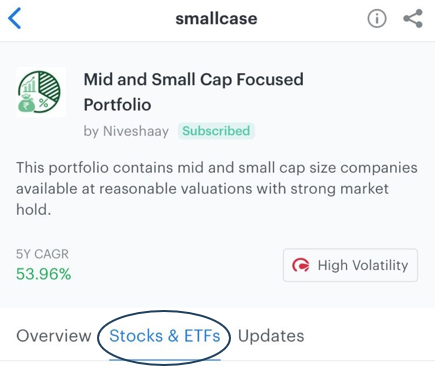Frequently Asked Questions by Niveshaay Subscribers
May 27, 2024 | Deep Dives

Q1. Which Niveshaay smallcase should we invest in?
The choice of smallcase for investment depends on your investment horizon, risk tolerance, and financial goals. Each smallcase is designed with a specific investment objective and strategy in mind. It's essential to evaluate your own investment horizon and risk appetite before deciding which smallcase aligns best with your financial objectives.
We offer six smallcases and you can learn more about them here. To start with the investing journey, one can consider strategy-based portfolios such as Mid and Small Cap Focused Portfolio Fundamental, Trends Trilogy Fundamental, which are our diversified portfolios and cater to multiple sectors. You may also explore our thematic portfolios, such as Green Energy Theme, Niveshaay Consumer Trends Portfolio Theme, Make in India Theme. Recently we have also launched our Niveshaay IPO Basket Fundamental which provides a unique opportunity to invest early in companies set to become future industry leaders.
Q2. Is there any minimum investment requirement for your portfolio?
The minimum investment amount is calculated based on the underlying stocks and their weights, based on the current market price. Once this amount is invested, the SIP amount will be fixed.
The SIP amount is calculated based on your Minimum Investment Amount (MIA). If the investment amount is less than INR 12,000, then the minimum SIP amount equals the investment amount. If the investment amount is more than INR 12,000, then the minimum SIP amount is twice the value of the highest-valued stock rounded up to the next 1000.
To maintain an optimal expense ratio, we suggest a minimum investment of Rs. 4–5 lakhs in our Smallcase. Click here to learn more about achieving the ideal expense ratio.
Q3. How should one deploy funds?
We recommend investing in a SIP (Systematic Investment Plan), as it enables accumulating cash gradually for lump-sum investments when needed.
Q4. What duration is optimal for investing?
At Niveshaay, our investment strategy is oriented towards the long term, with focus on sectors and industries poised for high growth in terms of revenue, earnings, and cash flow. This could be due to industry-wide healthy tailwinds or the turnaround of a particular company. Given the inherent volatility of markets, we always recommend keeping an investment horizon of 3–5 years to reap the maximum benefits.
Q5. How much return can we expect?
We advise investors to uphold long-term investments to maximize returns, particularly given the market’s volatility. It’s important to note that, in accordance with SEBI regulations, we refrain from making any commitments or assurances of guaranty or risk-free returns to investors.
Q6. How frequently does rebalancing happen?
Our dedicated research team consistently monitors the portfolio, tracking each company and its developments. We swiftly rebalance whenever there are significant shifts in fundamentals or market sentiment or when new company-specific opportunities arise. Furthermore, we typically rebalance after the quarterly results season. We'll keep you informed via email and WhatsApp whenever a rebalancing occurs.
Q7. How do I execute a rebalance?
Steps to apply rebalance
- From your Investments page, click “Rebalance” where available.
- Review the update or make changes by clicking on "Customize"
- Confirm the update and place orders.
Please note:
Your smallcase will be rebalanced only when you confirm and place the order; it will not be done automatically.
Q8. Where can we find the rationale behind the rebalance?
We offer our research analysis in the rebalance rationale report.
Steps to find the rebalance rationale report:
- Login to your smallcase account.
- Click on Discover.
- Search for the Niveshaay smallcase that you have subscribed to.
- Click on Stocks & ETFs.
- Scroll down and click on “See Report” to read the rationale behind the rebalance.

Q9. How should one respond when stocks reach the upper or lower circuits?

You might have noticed this error during rebalancing. This situation arises when stocks get stuck in circuits, either upper or lower, preventing buying or selling until they exit circuits. When stocks hit the upper circuit, it indicates a shortage of sellers, while hitting the lower circuit implies a shortage of buyers. This halts trading, potentially causing the rebalance order to not execute. In such cases, we request not to archive the order. Instead, once stock exits the circuit, we kindly request that you go to your Smallcase account and execute a 'REPAIR ORDER'.
If you mistakenly archived the order, you can reverse it by emailing support@smallcase.com. If you executed the order directly through your broker, please email support@smallcase.com and smallcase@niveshaay.com, providing the stock's name, price, quantity, and date of transaction from your registered email ID to facilitate order reconciliation.
Q10. How do I access the manager updates sent by Niveshaay?
To explore the manager update section, please navigate to the Smallcase application and follow these steps:
- Log in to the Smallcase application.
- Search for Niveshaay Portfolio
- Click on the Updates section.

Q11. What are LiquidBees/Liquidcase ?
LiquidBees, an exchange-traded fund (ETF), functions as a cash equivalent within smallcase, a portfolio where full fund deployment is required. This strategy allows for maintaining liquidity, particularly during times when market valuations are high and holding cash enables quick liquidation as needed, facilitating taking positions in equities.
Q12. The stocks listed in my broker account differ from those in my Smallcase App.
This occurs when transactions are conducted directly through a broker account, resulting in discrepancies in holdings and returns. You can easily reconcile your holdings by simply dropping us a mail at support@smallcase.com and smallcase@niveshaay.com, providing the stock's name, price, quantity, and date of transaction from your registered email ID.
Q13. Where can we find the original composition of smallcase?
You can find the original composition by following these steps:
- Log in to your smallcase app.
- Navigate to the 'Discover' section and search your subscribed Niveshaay smallcase.
- Click on “Stocks and ETFs” to explore the detailed breakdown of the original portfolio composition.

Q14. What are your charges above subscription fees?
We prioritize your trust and satisfaction and do not levy any extra charges beyond our subscription fees. However, it's essential to acknowledge that, apart from subscription fees, there are transaction charges imposed by smallcase, along with brokerage and STT, applicable each time you trade shares through your broker. Nevertheless, the primary expense remains the subscription fees, with these supplementary charges kept minimal on the platform to enhance your investment journey.
Q15. Can we add or remove stocks from Smallcase?
You have complete control over adding or removing stocks at any time.
- Select a smallcase from your Investments page and click on "Manage"
- Change the quantities of your constituents OR add OR remove a stock.
- Once done, review the changes and place your order.
Please Note: If you manage smallcase then it will deviate from the original idea, and we do not recommend doing the same. However, if you still wish to continue, you will continue to receive rebalance updates, and your SIP (if active) will also be updated accordingly.
Q16. What is an expense ratio, and how much should be the ideal expense ratio?
The expense ratio is the ratio of the subscription fee to your total investment value.
Expense Ratio = Annual Subscription Fee / Total Planned Investment by Year
For example, if the expense ratio is 20%, it means you're paying 20% of your total investment value as a subscription fee. That means you need to earn a minimum of 20% returns just to break even with your investment value.
It's advisable to keep your expense ratio minimal for any investment. We recommend aiming for an expense ratio between 2–3% for Niveshaay smallcase. Considering our subscription fees, we suggest investing a minimum amount of Rs. 4–5 lakhs to maintain the desired ratio.
Note: Subscription fees are a major expense, and all other expenses are very minimal compared to others.
Disclaimers and Disclosures
SEBI Registration No. :INH000017338, IN/AIF3/24-25/1571, IN/AIF2/24-25/1607 | BASL Membership ID: 6276
Investment in Securities Market are subject to market risks. Read all related documents carefully before investing. The securities quoted are for illustration only and are not recommendatory. Registration granted by SEBI, membership of a SEBI recognized supervisory body (if any) and certification from NISM in no way guarantee performance of the intermediary or provide any assurance of returns to investors.


 Follow
Follow